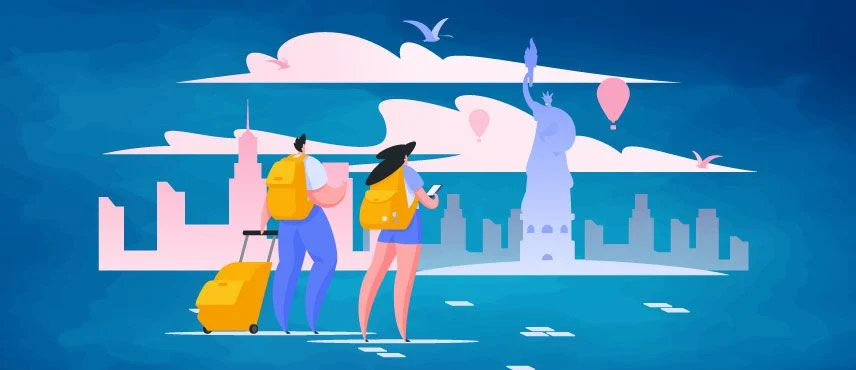India is a top destination for travelers worldwide, offering a blend of history, culture, spirituality, and adventure. For US citizens planning to visit India, obtaining a visa is a necessary step before embarking on their journey. The Indian government offers several visa options tailored to various travel purposes, including tourism, business, medical treatment, and more. This article outlines the process for US citizens to apply for an Indian visa, the types of visas available, and helpful tips to ensure a smooth application process.
Types of Indian Visas for US Citizens
INDIAN VISA FOR US CITIZENS The Indian government provides a range of visa types to cater to different travel needs. Here are the most common visas available to US citizens:
- Tourist Visa The Tourist Visa is the most commonly issued visa for travelers visiting India for leisure, sightseeing, or family visits. US citizens can apply for a regular tourist visa, which typically allows stays of up to six months. Alternatively, those planning short visits can apply for an e-Tourist Visa (eTV), which is a simplified online process. The eTV is valid for 60 days and can be extended under certain circumstances.
- Business Visa A Business Visa is designed for US citizens traveling to India for business-related activities such as attending meetings, conferences, or exploring commercial opportunities. This visa allows multiple entries and is typically granted for six months or one year, depending on the applicant’s business needs.
- Medical Visa India is known for its advanced medical facilities and affordable healthcare, making it a popular destination for medical tourism. The Medical Visa is for US citizens seeking treatment in India. It is usually issued for six months and can be extended under special circumstances. Accompanying family members can apply for a Medical Attendant Visa.
- Student Visa US citizens planning to study in India need a Student Visa. This visa is granted for the duration of the applicant’s academic course. US students must present proof of admission to a recognized institution in India to qualify for the Student Visa.
- Employment Visa US citizens who have received a job offer from an Indian company or organization can apply for an Employment Visa. This visa allows the holder to stay in India for the duration of the employment contract and is extendable under certain conditions.
- Conference Visa The Conference Visa is intended for US citizens attending international conferences, seminars, or workshops in India. It is granted for the duration of the event, typically allowing a stay of up to 30 days.
How to Apply for an Indian Visa
US citizens can apply for an Indian visa through two primary methods: online (e-Visa) or through the traditional paper visa application process.
Option 1: Applying for an e-Visa
INDIAN VISA FOR BULGARIAN CITIZENS The e-Visa is the most convenient and popular option for US citizens traveling to India. Here’s how to apply:
- Visit the Official e-Visa Website: Go to the official Indian e-Visa website to begin the application process.
- Complete the Application Form: Fill out the online application form with your personal details, travel information, and purpose of visit.
- Upload Documents: You will need to upload a scanned copy of your passport, a recent passport-sized photograph, and other documents (such as an invitation letter for business travelers).
- Pay the Visa Fee: The visa fee can be paid online using a debit or credit card.
- Receive the e-Visa: Once your application is processed and approved, the e-Visa will be sent to your email. Print a copy of the e-Visa to carry with you when you travel to India.
Option 2: Traditional Visa Application
For travelers who do not qualify for an e-Visa, or prefer a traditional application method, US citizens can apply for a visa at the Indian Embassy or Consulate. Here’s the process:
- Fill Out the Application Form: Download the visa application form from the Indian Embassy’s official website, fill it out with accurate details, and sign it.
- Prepare Documents: You will need to submit a valid passport with at least six months of validity from your intended arrival date in India, passport-sized photographs, and any additional documents required for your specific visa type (e.g., business invitation letter or admission letter for students).
- Submit the Application: Submit the completed form and required documents at the Indian Embassy or Consulate in the US. Some consulates may require an appointment for submission.
- Pay the Visa Fee: Visa fees can be paid by money order, credit card, or in person, depending on the consulate’s requirements.
- Processing Time: Traditional visa processing typically takes 7-10 business days, though expedited processing may be available for an additional fee.
- Receive Your Visa: Once approved, you can either pick up your visa at the consulate or have it mailed to your address.
Documents Required for Indian Visa Application
Depending on the visa type, US citizens may need to provide different documents. Here is a general list of documents required for most visa applications:
- A valid passport with at least six months of validity beyond the planned date of arrival in India.
- A completed visa application form.
- A recent passport-sized photograph (meeting the specified size and format).
- Proof of travel arrangements, such as flight tickets and hotel bookings.
- For business visas, a business invitation letter from an Indian company.
- For medical visas, documents supporting medical treatment requirements.
- For student visas, proof of admission to a recognized educational institution in India.
Visa Processing Time and Fees
- e-Visa Processing Time: Typically, e-Visa processing takes 3-5 business days.
- Traditional Visa Processing Time: This usually takes 7-10 business days but can vary depending on the consulate and the type of visa.
- Visa Fees: Visa fees depend on the type and duration of the visa. The fee for an e-Visa is generally lower than that for traditional visas. Be sure to check the latest fee structure on the Indian embassy’s website.
Conclusion
Obtaining an Indian visa is a straightforward process for US citizens, with several visa options depending on the purpose of travel. Whether you are visiting for tourism, business, medical treatment, or study, you can apply for an e-Visa or submit a traditional visa application at an Indian consulate. Make sure to apply well in advance and provide all the necessary documents to avoid delays. With proper planning and preparation, you can easily secure your Indian visa and explore the rich culture, history, and beauty of India.



